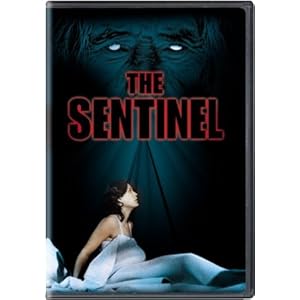
The Movie:
I think every religion should come with a cheat sheet for movies. Seriously. Those of us raised outside the religion will either miss the cultural references in flicks, or see them when they aren’t there. The latter was the case for The Sentinel. It was the second movie in a week I saw where a priest’s suicide attempt was connected to the portal to hell. So I watched it with that in mind, wondering how someone raised Catholic might react to the horrors presented. Then I talked to a Catholic and asked him about the Sentinels. The only ones he knew of were the TV show. Turns out there isn’t something in the Catholic faith that says suicidal priests get to guard the gate of Hell.
Go figure.
So now I get to judge The Sentinel from a totally secular standpoint. It wasn’t a horrible movie. Not the greatest in the world, but had just enough bits of random oddity to make it worth my while. The plot—a suicidal supermodel moves into an old apartment building, with strange and creepy neighbors and an even more creepy mute blind priest living on the top floor. But something terribly wrong MUST be going on…and it is.
There isn’t much in the story to set it apart from other 1977 flicks. But the cast includes some very early work from Jeff Goldblum, Christopher Walken (whose presence automatically makes a movie half a notch cooler) and Beverly D’Angelo as a psychotic masturbating lesbian. It was such a bizarre experience to watch her playing with herself, all the while thinking “And this is the woman who will one day become Mrs. Griswold.” Burgess Meredeth always shines in evil roles, and he was a fun treat to watch.

There are certain movie moments that I call “cow clips”; the one thing that saved Twister from being one of the worst movies of the year was the fact the cow mooed as it was being swept up in a tornado. The Sentinel was filled with “cow clips”. Our main character accidentally wanders in on her father’s birthday celebration, including overweight hookers and cake. The abovementioned extended masturbation scene, a birthday party for a cat with dialogue that would make Lynch and Jodorowsky scratch their heads. And then there is the infamous end scene, controversial for its use of deformed people as minions of hell. You just don’t see stuff like that in movies all that often.

As a whole, The Sentinel is much lesser than its individual parts. However, if you look at it bit by bit, those moments of weirdness and trivia of “holy crap, I didn’t know (fill in the blank) was in this!” then it will be a fun thing to sit through. Beverage refreshment might help. I suggest Mike’s Hard Pink Lemonade. Not that I had any experience with that…
- Jenny

The Book:
The best thing I can say about The Sentinel by Jeffrey Konvitz is that it was made in the 1970s. 1974, to be precise.
I hope the book was an attempt to cash in on the popularity of The Exorcist. That, at least, would make the story development and subject matter more understandable. Members of the Catholic clergy appear throughout the book, often in ways that make the reader uncertain as to whether they’re good or evil. It might have more of an impact if anything in the book was presented as a certainty; instead, literally every character can be interpreted in multiple ways until the very end of the book. While the massive ambiguity of motivation neatly fosters a feeling of persecution the lack of any stable core prevents any underlying fear on the part of the reader; it’s all too easy to relegate Allison to a position of potential paranoid.
Then, at the end of the book, all is explained and everyone’s role is specifically defined. This shifts the story immediately from being too obtuse to being overly simplistic, and it does so with a speed that jars the reader from the story. It is, simply, a story inexpertly told.
But remember what I said earlier about 1974?
This book was released at a time when gothics were only finally fading as the most popular form of horror or suspense, and when oddity was a new art form in horror as opposed to inspiring its own bizarre subgenre.
The fact is that this book is ploddingly average when compared to the typical zebra, leisure or pinnacle book lines of the 1980s… and the fact is that while those book lines produced some wonderful books by excellent authors, they also published an amazing quantity of drek.
If I’m feeling generous, then, I might give this book three stars because it was, if not a true trailblazer, at least one of the earlier examples of this style of novel.
Unfortunately, this style of novel is pretty bad, and I’m not feeling particularly generous.
Two stars out of five.
- Bill
